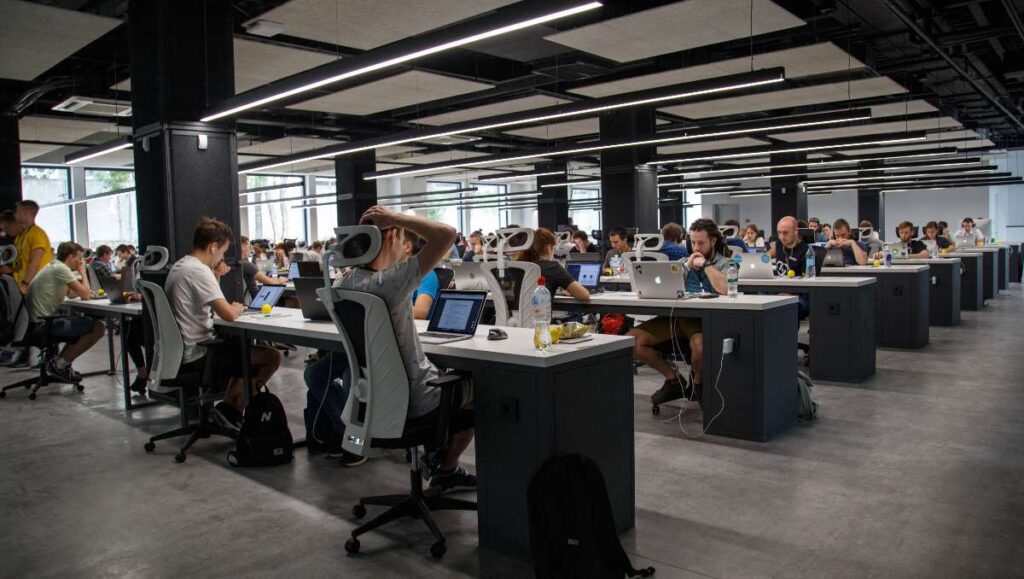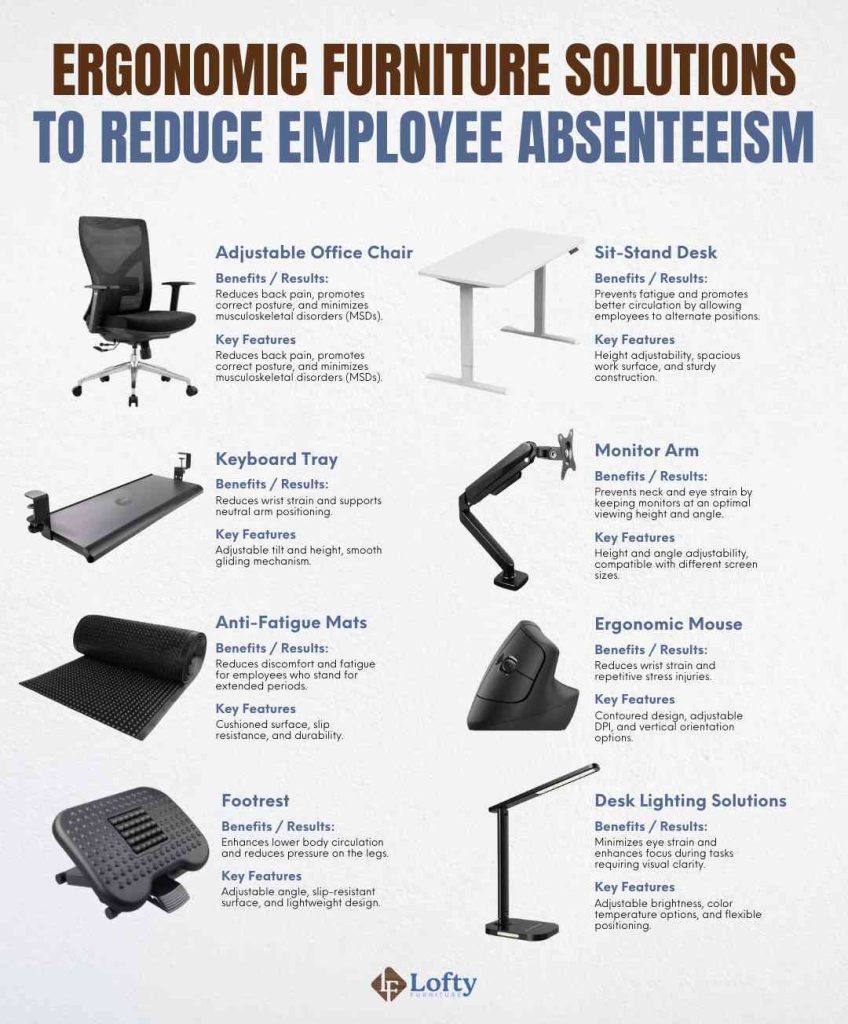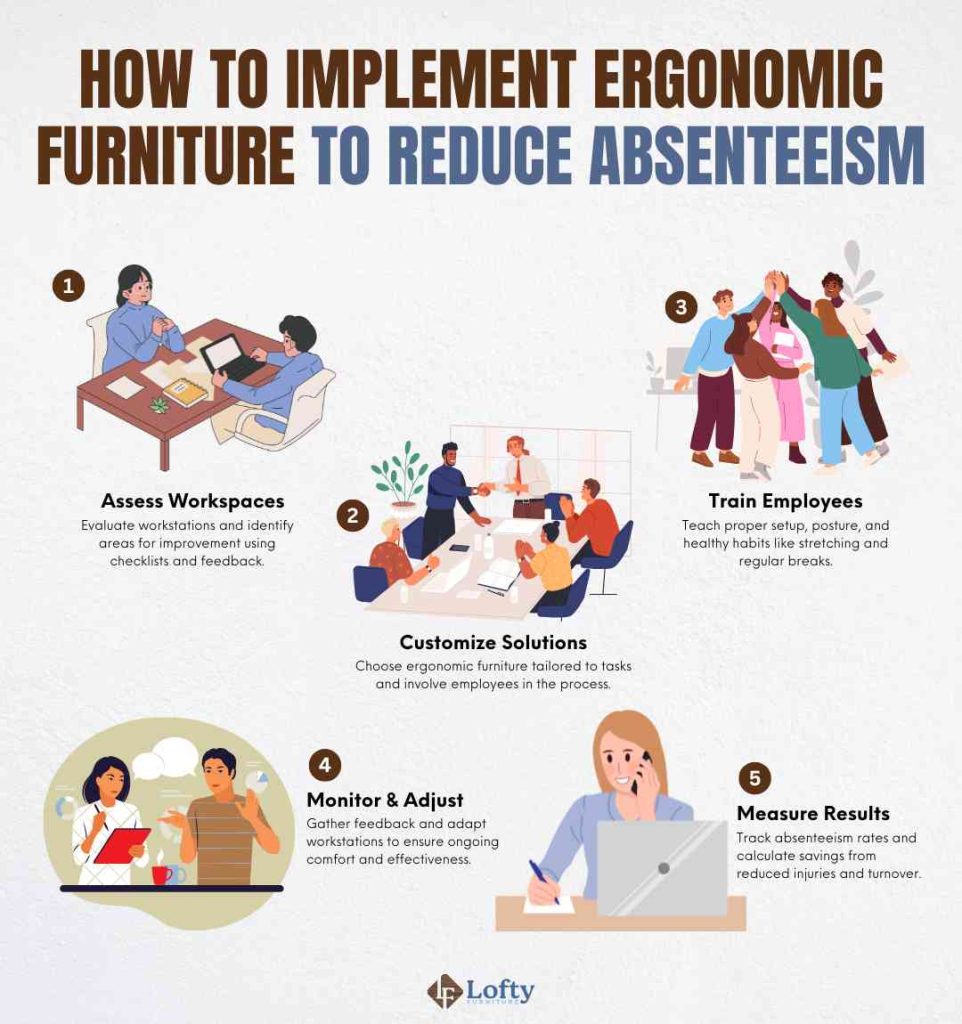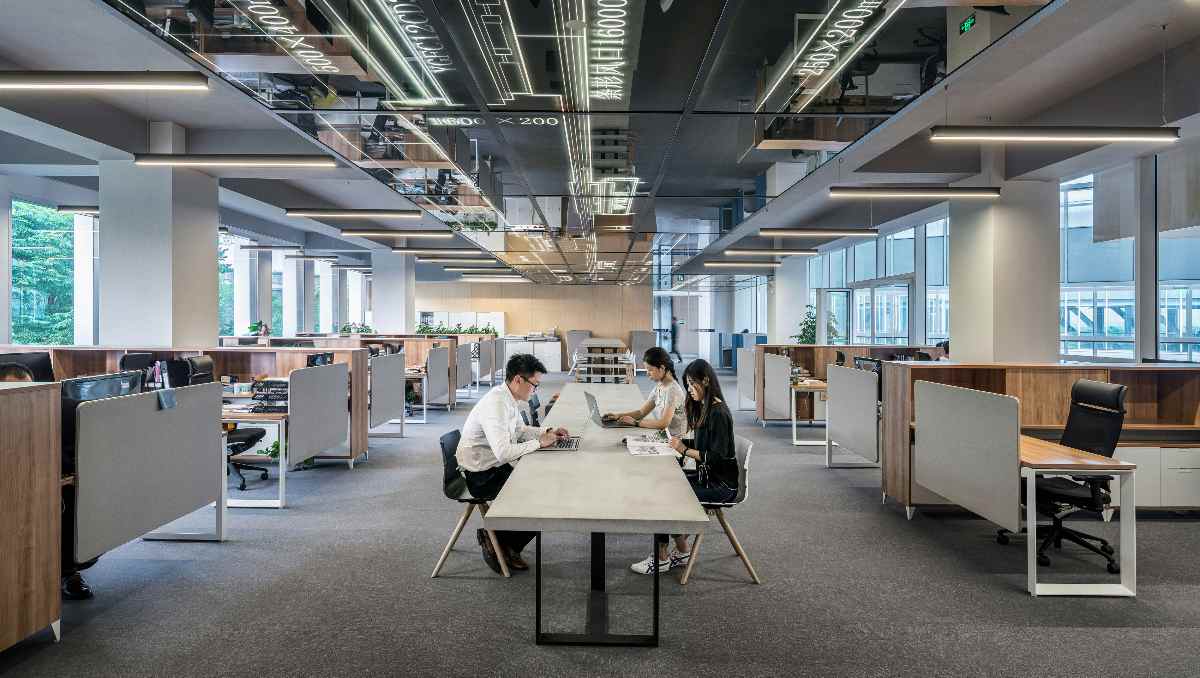Employee absenteeism is a growing concern for businesses worldwide, often leading to decreased productivity, higher operational costs, and a negative impact on workplace morale. While many factors contribute to absenteeism, one often overlooked aspect is the physical work environment. Poorly designed workspaces and uncomfortable furniture can make it harder for employees to remain present and productive. This is where ergonomic benefits comes into play.
Key Takeaways
- Ergonomic interventions reduce absenteeism by preventing injuries, alleviating discomfort, and promoting employee health.
- Tailored ergonomic solutions, such as proper furniture and training, improve workplace comfort and productivity.
- Long-term cost benefits include lower healthcare costs, reduced turnover, and fewer sick days, making ergonomic investments a smart financial choice.
This article explores how ergonomic furniture can play a pivotal role in mitigating absenteeism, ultimately benefiting both employees and employers.
The Science of Ergonomics and Employee Health

Ergonomics is the scientific study of designing work environments, tools, and systems to optimize human well-being and performance. By tailoring workplace setups to the physical and cognitive needs of employees, ergonomics aims to reduce strain, enhance comfort, and improve overall well-being and productivity.
Poor ergonomic practices in the workplace can have significant health repercussions, ranging from immediate discomfort to long-term chronic issues. A study highlights the high rate of worker absenteeism generated by musculoskeletal disorders due to the high postural load at the stations of work in this industry. MSDs not only limit employees’ physical capabilities but also result in frequent absences, disrupting workplace operations.
Guillaume Drew, founder of Or & Zon, underscores the importance of addressing absenteeism from a holistic perspective:
“Attending absenteeism not only protects employees’ self-respect but also encourages them to be more active and healthy. “
How Ergonomic Interventions Reduce Absenteeism
By incorporating ergonomic furniture into the workplace, organizations can create healthier and more productive environments.

Mitigating Health Risks
Ergonomic interventions play a crucial role in mitigating health risks by addressing common workplace ailments such as musculoskeletal disorders (MSDs), chronic pain, and fatigue. Ergonomic furniture ensures that employees maintain proper posture and avoid repetitive strain injuries. Research has shown that improved ergonomic setups correlate with fewer sick days. When employees work in environments tailored to their physical needs, they experience reduced physical strain, leading to fewer instances of work-related injuries or illnesses.
💡 A study tested an ergonomic workstation intervention to reduce pain in office workers over 36 weeks. The intervention lowered pain in the neck, shoulders, upper back, and wrists.
Supporting Workplace Comfort and Productivity
Comfort in the workplace is directly tied to productivity. Ergonomic interventions, like ergonomic desk accessories, reduce physical discomfort, which often serves as a distraction for employees, allowing them to focus more effectively on their tasks.
Jeremy Yamaguchi, CEO of Lawn Love, emphasizes this point:
“An ergonomic desk chair allows you to sit in a way that is healthy for your body and actually feels good. You spend less time slouching and slipping into bad posture, and that actually helps keep you more awake and focused.”
Take your ergonomic setup to the next level!
Explore our collection of Walking Pads & Treadmills and stay active while working or relaxing at home.
Reducing Employee Turnover
Ergonomic interventions not only address absenteeism but also positively impact employee retention. When employees feel comfortable and supported in their roles, they are more likely to experience job satisfaction, which strengthens their commitment to the organization.
💡Research found that companies with comprehensive ergonomics programs experienced an average 48% reduction in employee turnover and a 58% reduction in absenteeism.
This data highlights the long-term value of ergonomic interventions in promoting a healthier, happier workforce, reducing turnover costs, and boosting organizational efficiency. By prioritizing ergonomics, companies can create a workplace culture that values employee well-being and fosters loyalty.
Ergonomic Solutions That Drive Results
Tailoring ergonomic furniture and tools to individual employee needs is crucial for maximizing their benefits. For example, employees who spend long hours at desks may need adjustable office chairs and ergonomic standing desks, while those performing repetitive tasks might benefit from anti-fatigue mats, standing desk balance board, ergonomic couch for rest times, and wrist supports. Proper training is also essential to ensure that employees use ergonomic tools correctly and effectively.
As Myles Mclean from Grill Hound explains,
“Challenges such as initial costs and employee adaptation exist, but these can be addressed with proper training and gradual implementation. Ensuring long-term sustainability requires regular assessments and maintaining ergonomic standards.”

Business Case: ROI of Ergonomic Furniture
Implementing ergonomic furniture solutions can lead to significant financial savings and ROI for businesses. These include reductions in absenteeism, lower employee turnover rates, and fewer injury claims. For example, data from the Health & Safety Executive reveals that in 2021-2022, 473,000 workers suffered from musculoskeletal conditions, leading to a total of 6.6 million working days lost. Addressing such widespread issues with ergonomic interventions directly impacts a company’s bottom line.
Investing in ergonomic furniture not only benefits employees’ health but also boosts job satisfaction and retention. Employees who feel their well-being is prioritized are more likely to stay loyal to their organization, reducing turnover and associated hiring costs.
As Matt Erhard from Summit Search Group explains,
“Even beyond lost work hours, absenteeism can mean higher payroll costs for overtime or additional workers who need to be scheduled to compensate for that absence. It’s also important to factor in the costs of Workers’ Compensation for injuries sustained through ergonomic issues.”
Implementing Ergonomic Interventions To Reduce Employee Absenteeism
Effective ergonomic interventions start with a workplace assessment to identify areas for improvement, such as workstations or seating. Training employees on proper use and maintaining posture is key. Regular feedback ensures solutions remain effective and adaptable.
As Beni Avni from New York Gates notes,
“Businesses track absenteeism reduction through methods like attendance monitoring, employee satisfaction surveys, and health assessments. Tools like ergonomic risk checklists and feedback surveys provide insight into workplace interventions’ effectiveness, aiding strategy refinement.”

Conclusion: The Power of Ergonomics in Reducing Absenteeism
While absenteeism stems from various factors, research shows that ergonomics plays a key role in addressing the issue. Implementing ergonomic furniture and practices enhances employee health, comfort, and focus, reducing musculoskeletal disorders and stress. These interventions are proven to lower absenteeism while boosting productivity, job satisfaction, and retention. By prioritizing tailored ergonomic solutions, companies cultivate a healthier, more engaged workforce and achieve sustainable, long-term cost savings.
FAQs
How do ergonomic interventions reduce absenteeism in workplaces?
Proper ergonomic setups improve posture, reduce strain, and promote overall health, leading to fewer sick days and a more productive workforce.
What are the long-term cost benefits of ergonomic furniture?
The long-term cost benefits of ergonomic furniture include reductions in absenteeism, healthcare costs, and employee turnover. Additionally, ergonomic setups boost productivity, engagement, and job satisfaction, leading to higher employee retention and lower turnover rates.
Can small businesses afford ergonomic interventions?
Yes, small businesses can afford ergonomic interventions by taking a gradual and strategic approach. Investing in ergonomic solutions doesn’t always require a large upfront cost. Starting with affordable, key ergonomic furniture such as adjustable chairs or standing desks can provide immediate benefits.
How do ergonomic tools help prevent workplace injuries?
Ergonomic tools, such as adjustable chairs, desks, and keyboard/mouse setups, are designed to promote better posture and reduce physical strain. They also encourage regular movement and proper sitting/standing positions, preventing long-term injury and ensuring a healthier, more comfortable work environment for employees.
